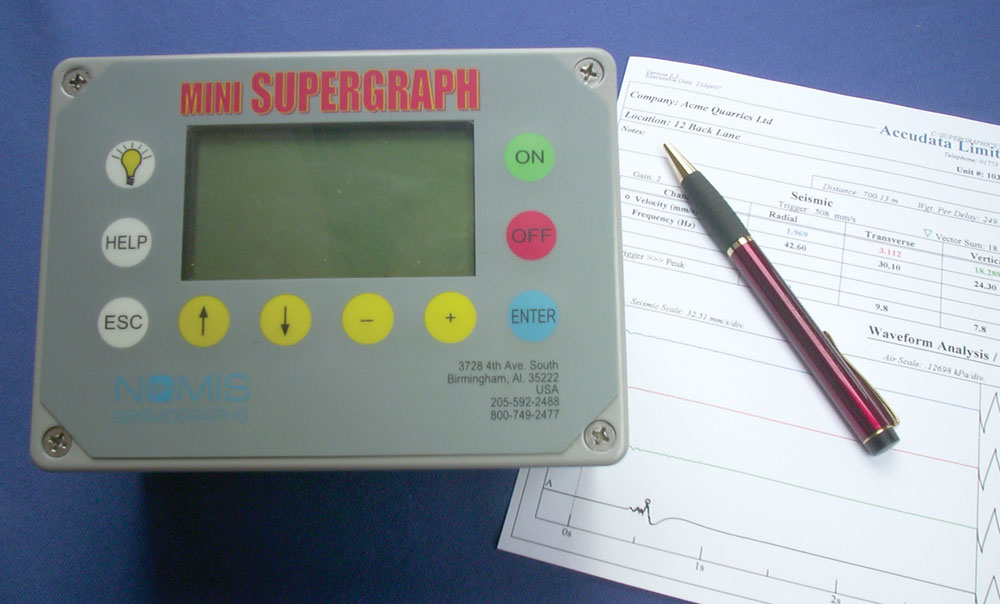The Mini-SuperGraph

A compact and powerful seismograph from Accudata
The Mini-SuperGraph seismograph from Accudata is claimed to be unique in that it allows different set-up parameters to be saved for immediate retrieval and use. For example, the user may store his/her name, location, distance to blast, maximum instantaneous charge, trigger level, sampling rate and scan time for several different monitoring locations. This means that upon arrival at a specific monitoring location, the user simply places the two sensor units, switches on the seismograph and selects their set-up for that location. This sequence only takes a matter of seconds, thereby considerably easing the operator’s burden, especially when weather conditions are unfavourable.
Nomis’ accuracy is well known, and at the start of each monitoring period a calibration reference pulse is sent to each of the geophone sensors. These reflect the signal back to determine that the system is within its calibration limits. The calibration pulses are displayed adjacent to the three vibration waveforms on the report.
After triggering, the LCD display shows the event number, date and time, and highest levels of peak particle velocity (PPV) in mm/s-1 in all three axes (radial, transverse and vertical), together with the frequencies and air overpressure in dB (linear peak). The data from any stored event may be reviewed on the LCD display. After downloading the data to a computer, powerful software produces a detailed A4 report-ready printout.
With reference to the printout depicted in figure 2, the company name and telephone number is shown, together with the filename, location, date and time, operator’s name, event number, record length, sampling rate and last calibration date. There is also space for any relevant notes. All the required details are shown, providing everything necessary for a complete record of the blast, including the distance to blast and the weight per delay. The scaled distance is then calculated, which may be used as an axis reference point in the development of a regression line.
The trigger level and vector sum are shown and the measured levels of peak particle velocity, together with their dominant frequencies, in each axis, and the elapsed time in milliseconds from triggering to the peak are tabulated along with the air overpressure in dB(L). Also shown on the scaleable graph are the calibration pulses, showing that the instrument is functioning correctly and accurately in each channel. If displacement is selected within the user set-up, its value, in millimetres, will also be displayed.
Finally, the BS7385 Part 2 graph shows frequency distribution with each axis having its own letter represented in colour, making it immediately obvious if levels have been exceeded. If used overseas, USBM or DIN standard graphs may be selected within the user set-up.
The Mini-SuperGraph may be triggered several times, with no wait time between events, and at least 300 two-second events may be stored in the memory.
The integral gel battery is able to power the instrument for many days, or even weeks, before recharging is necessary, and if the seismograph is to be left running in an unattended mode, battery life may be further extended by the use of an in-built timer function. This can be set so that the instrument switches itself on and off at pre-set times during the week and remains off on Saturdays and/or Sundays. In addition, to further extend battery life, the LCD goes blank after a pre-set time between 2min and 60min, as determined by the user (the default setting is 2min).
The standard sampling rate is 1,024 samples per second, but for diagnostic work alternate sampling rates of 2,048 and 4,096 samples per second may be selected. A factory-fitted option allows a sampling rate of 8,192 samples per second.
The SuperGraphics software supplied with the Mini-SuperGraph for transferring data from the seismograph to a computer is powerful yet easy to use, with navigation via smart-icons. After downloading, files are located in a directory within the SuperGraphics directory but may be stored in any chosen directory for easy archiving.
With the Mini-SuperGraph connected to the computer, a list of stored events is shown. A single click selects all the events to be downloaded, but if it is obvious that spurious events are present, these may be ignored with only those of interest being selected for download.
When the event data are downloaded, the software allows the user to perform various post-processing functions. It is possible to highlight and zoom into areas of the graphs that may need closer examination. With just a single click, a Fast Fourier Transform (FFT) plot can be generated or the event data can be exported into a spreadsheet.
Within the user set-up options, there is a choice of six languages, including English, French, Spanish, Italian and German.
If the Mini-SuperGraph is to be used for long-term unattended monitoring, the instrument is able to run from an external power supply or solar panel. Remote communication and downloading may also be carried out if the seismograph is connected to a modem.
Accudata say the Mini-SuperGraph is the result of years of research and development that builds upon previous generations of seismographs and, by utilizing the latest technology, provides a powerful, compact and easy-to-use seismograph that records everything necessary to fully comply with vibration-monitoring regulations when blasting.
The seismograph is supplied in a carrying case with a tri-axial geophone sensor unit, complete with three removable ground spikes, air overpressure microphone with windshield and support mast, a download lead, a battery charger, the SuperGraphics software, 12 months warranty, a calibration certificate, a quick-start guide and full user instructions.
Accudata Ltd, Aspect House, 48 The spinney, Ripley, Derbys DE5 3HW; tel: (01773) 513222; email: info@accudataltd.co.uk


